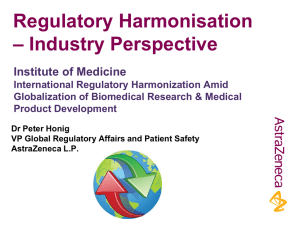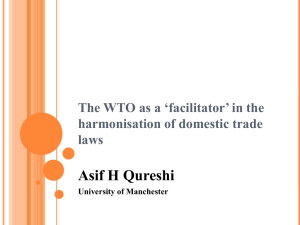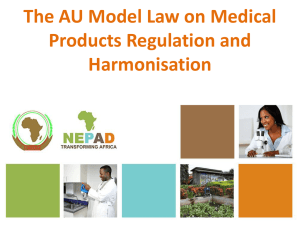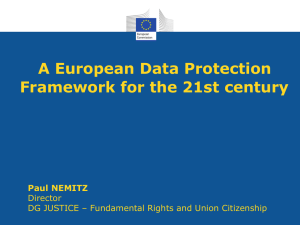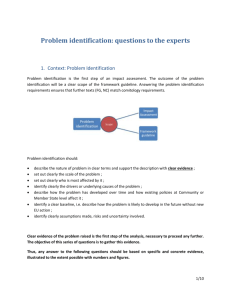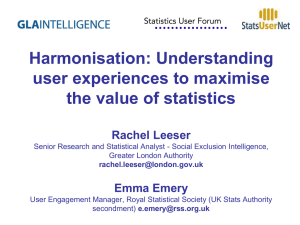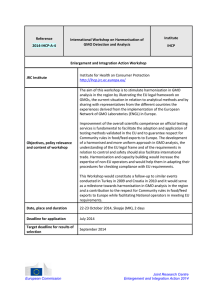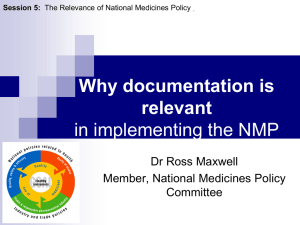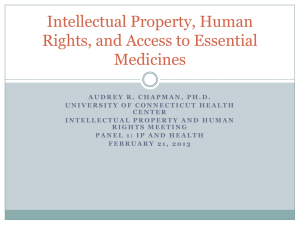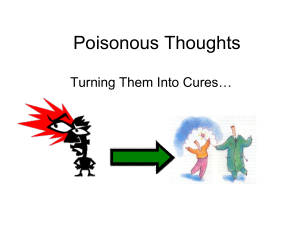AFRICA REGULATORY CONFERENCE FEEDBACK
advertisement
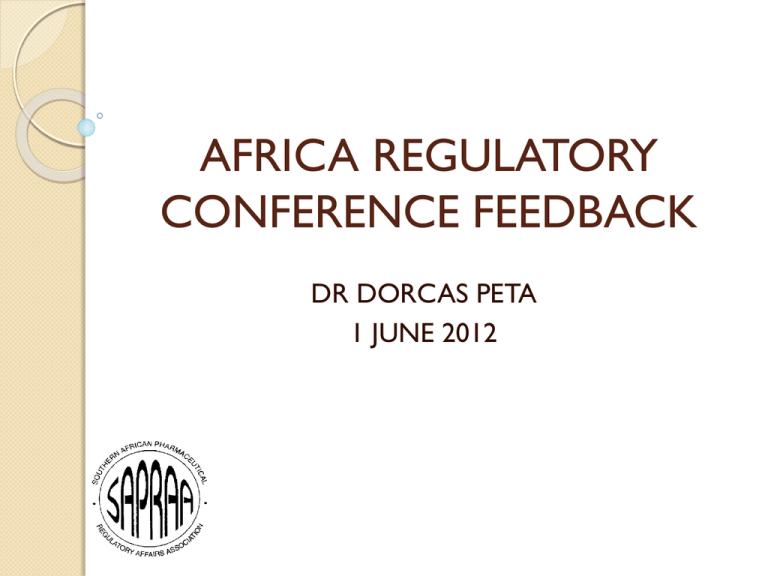
AFRICA REGULATORY CONFERENCE FEEDBACK DR DORCAS PETA 1 JUNE 2012 ACKNOWLEDGEMENT This presentation is a summary of presentations delivered at ARC by the various speakers. It is intended to provide feedback to SAPRAA members who were unable to attend the conference. TOPICS TO BE COVERED Supply chain integrity (Quality of API & FP) Regulatory harmonisation in Africa Partnering to strengthen Africa’s regulatory and ethical processes How to further develop common ground for PV and clinical trials Supply chain integrity - - - General principles: Each stage of manufacturing API and FP should be conducted in according to marketing authorisation, GMP and approved guidelines Each batch of FP must be certified by a qualified person before being released for sale/export Sites are to be inspected for GMP and repeat inspection should also take place Supply chain integrity cont. - - Supply chain challenges for regulators and industry: Global supply Counterfeits Cargo theft and diversion Complex global supply chain and increases outsourcing of manufacturing Internet Supply chain integrity cont. Solutions for the challenges: - Improving efficiencies - Improving communication and transparency - Collaboration with other authorities, law enforcement agencies and industry - Licenced distributors, wholesalers, manufacturers and pharmacies - Record keeping and traceability throughout the chain Supply chain integrity cont. - Use of technologies for prevention and management of counterfeits Education of stakeholders and the consumer Strengthen global detection, surveillance and assessment systems Licenced distributors, wholesalers, manufacturers and pharmacies Record keeping and traceability throughout the chain REGULATORY HARMONISATION IN AFRICA AMRH/NEPAD Update: The MRH project development objectives are to harmonise medicines registration systems and to improve efficiency and enhance transparency in medicine registration amongst participating members in RECs. Each REC develops its harmonisation model based on its context. - Successful EAC MRH Project launch on 30 March 2012 in Arusha, Tanzania - Focus on medicines registration as a pathfinder to harmonise other regulatory functions REGULATORY HARMONISATION IN AFRICA cont. Other REC MRH projects include: - SADC MRH project proposal - ECOWAS MRH project proposal - N/NE Africa Region: Situational analysis study ongoing - ECCAS Region: Situational analysis study ongoing Regulatory training programmes Regulatory capacity building and systems strengthening REGULATORY HARMONISATION IN AFRICA cont. The East African Community (EAC) Update: - EAC is a regional grouping of 5 Partner States (Burundi, Kenya, Rwanda, Tanzania and Uganda) - 5 year EAC MRH project proposal submitted to donor agencies and approved for funding through the World Bank - Project launched on 30 March 2012 REGULATORY HARMONISATION IN AFRICA cont. 4 TWGs established with lead Partner State NMRA, June 2011. - TWG on medicine registration – Tanzania - TWG on GMP Inspection – Uganda - TWG on IMS – Rwanda - TWG on Quality Management - Kenya REGULATORY HARMONISATION IN AFRICA cont. - The goal is to have a harmonized and functioning medicine registration system within the East Africa Community in accordance with national and internationally recognized policies and standards (WHO & ICH) REGULATORY HARMONISATION IN AFRICA cont. Southern Africa Development Community (SADC) Update: - There is SADC-NEPAD interface for the harmonisation of medicines registration in the SADC region - Currently some MRAs have their own national guidelines for registration of medicines. These guidelines are not uniform between countries. REGULATORY HARMONISATION IN AFRICA cont. - - Others do not have guidelines or legal framework for registration At the regional level guidelines are available but implementation at country level has not yet been established The objective is aimed at correcting this situation REGULATORY HARMONISATION IN AFRICA cont. Existing limitations: - Different evaluation procedures - Different levels of expertise between Member States - Outdated guidelines - Lack of information sharing among Member States - Limited human resources in terms of skills and numbers REGULATORY HARMONISATION IN AFRICA cont. - Lack of legal framework for registration in some Member States Lack of political will in some Member States Inadequate financial resources from Government and fees from industry REGULATORY HARMONISATION IN AFRICA cont. Current status on regulation of medicines: - 3 Countries have autonomy in MRAs: Tanzania, Zambia and Zimbabwe - 3 Countries do not have MRA in place: Lesotho, Seychelles and Swaziland - 8 Countries have departments in MoH Angola, Botswana, DRC, Namibia, Malawi, Mauritius, Mozambique and S. Africa REGULATORY HARMONISATION IN AFRICA Economic Community of Western African States (ECOWAS)-West African Health Organisation (WAHO) Update: Strengthen the capacity of units of production of Health Prooducts: - WAHO identified 6 production facilities that had potential and were ready to be updated: 3 in Nigeria, 2 in Ghana and 1 in Cape Verde REGULATORY HARMONISATION IN AFRICA cont. - - - From 2008-2010, manufacturers were supported in developing feasibility studies, business plan and drawing plans for their plants Developed a regional strategy policy and legislation under TRIPS 17 NQCL assessed and categorised into 3 groups with regards to strength in performance, equipment and appropriate human resource availability Guidelines and training manuals developed for QC labs to use and develop own lab manuals, safety and record systems. REGULATORY HARMONISATION IN AFRICA cont. Formulated strategies for the fight against counterfeit and illicit medicines trade with the formation of ECOWAS Medicines Anticounterfeit Committee in May 2011. - Developed strategies and mechanisms for the harmonisation of policies, legislations and pharmaceutical regulations. - Project proposal sent to NEPAD for support - NMRAs trained on GMP - CTD and training manual developed for the MRH implementation by Member States - Established National Immunization Technical Advisory Groups in ECOWAS Member sates - REGULATORY HARMONISATION IN AFRICA cont. - Strengthen the accessibility of quality medicines through sound procurement systems e.g. Coordinated Informed Buying (CIB), bulk purchase of medicines, regional supply master plan REGULATORY HARMONISATION IN AFRICA cont. The African Vaccine Regulatory Forum (AVAREF) Update: - Represented by 19 countries, target CT of HIV, Malaria, TB, Meningitis and Vaccines - Legal framework (12 of 19 countries now have regulations for CT). - Clarification of mandates of EC and NRAs for the 19 countries. - Training of GCP, joint reviews and inspections of CTs. REGULATORY HARMONISATION IN AFRICA cont. - Collaboration between Ecs and NRAs (3 joint reviews of CTAs) - Pan-African Clinical Trial Registry established (WHO primary registry) - Networking among country NRAs and Ecs (3 joint reviews and 2 inspections) - A clear strategy developed for the future (Pan-Africa Clinical Trial Alliance (PACTA) SAFE MEDICINES: HOW TO FURTHER DEVELOP COMMON GROUND FOR PV AND CTs PV – HA Perspective: - Report all suspected AE to allopathic medicines, traditional, alternative, herbal medicines, x-ray contrast media, medical devices and cosmetics. - Report product quality problems - A form (Pink form) to be completed - Challenges include sustaining the reporting culture, funding of PV activities, cocktail therapies and legal weakness. SAFE MEDICINES: HOW TO FURTHER DEVELOP COMMON GROUND FOR PV AND CTs cont. Recommendations for improving PV process (Industry Perspective): - Leadership and dedicated personnel - Policies and strategies for PV - Guidelines and standards - Exchange of information and networking with international groups to continue - Sharing of best practices between countries - Training and awareness programs to HCPs - All partners, industry, HA, HCP and NGOs to work together SAFE MEDICINES: HOW TO FURTHER DEVELOP COMMON GROUND FOR PV AND CTs cont. Clinical Trials – HA Perspective: - Need for harmonisation of legislation, guidelines and standards for clinical trials - Sharing of data among national governments - Quality assurance of trials conducted in Africa - Need for post registration safety followup that is responsive to the local need and the data can be shared with all SAFE MEDICINES: HOW TO FURTHER DEVELOP COMMON GROUND FOR PV AND CTs cont. Clinical Trials – Industry Perspective: - High quality, scientifically credible and clinically relevant research is being conducted in Africa. - Require improved clarity, transparency and consistency of regulations and guidance - Greater commitment to develop and support research infrastructure from all stakeholders - Greater commitment from sponsors including industry to design and conduct relevant research SAFE MEDICINES: HOW TO FURTHER DEVELOP COMMON GROUND FOR PV AND CTs cont - - More predictable and transparent regulatory approval process, ideally with a single centralized procedure covering multiple countries Sustainable business models appropriate for resource limited settings that result in substantially improved post-approval process THANK YOU
